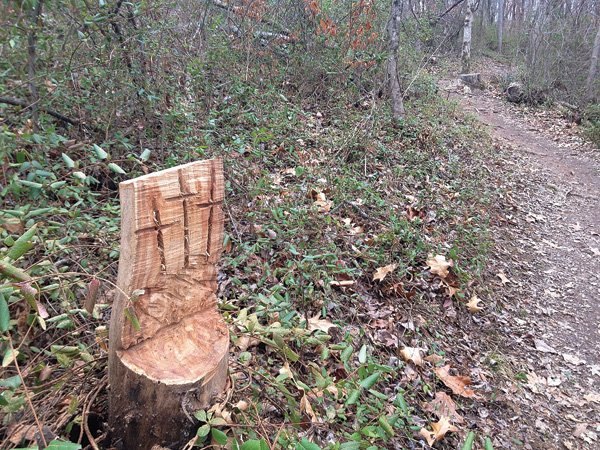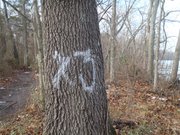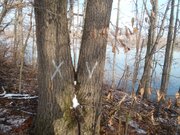FAYETTEVILLE — When a tree is marked in the woods, does anybody mind?
For the Fayetteville Parks and Recreation Department, it depends on where and how the markings are made.
Fayetteville Parks and Recreation staff filed a police report earlier this month after residents complained nearly 80 trees had been sprayed with silver paint along the south end of the Lake Fayetteville nature trail.
The trees featured a range of letters, numbers, shapes and symbols, including several trees marked “X3.”
“It’s graffiti, and we’ve reported it to the police,” said Connie Edmonston, Parks and Recreation director. “It’s just not the way you treat a living plant.”
Edmonston and Byron Humphry, parks maintenance superintendent, said this week they were less concerned, however, about carvings a longtime city employee has routinely made when cutting down dead or dying trees.
Gary Kilpatrick, a parks maintenance worker who has worked for the city 19 years, said he never thought people could have a concern with the small crosses he sometimes etches with the tip of a chain saw — usually on tree stumps he leaves behind in his work for the city.
The crosses can be found scattered along the nature trail south of Lake Fayetteville — between Veterans Memorial Park and where a paved section of trail ends.
“Nobody’s ever said anything,” said Kilpatrick, a Christian. “I’ve always just had a good feeling about it.”
“I don’t do this all the time,” he added. “Just when the mood hits me and I think someone would be lightened by it.”
Kilpatrick mentioned two incidents on the Lake Fayetteville Trail — a university professor who killed himself near the spillway bridge in October and another man who reportedly attacked a woman on the trail in 2009.
Kilpatrick said, if either individual had seen his crosses, maybe they would have stopped, prayed and reconsidered their actions.
He said, if asked, he’d stop his stump carvings. His supervisor has been aware of his penchant for carving the Christian symbol as he works on city projects.
“If it was something we felt was objectionable, obviously, we wouldn’t allow it,” Humphry said. “But crosses, generally, are not seen as offensive.”
Humphry said the two and a half days it took city workers to conceal the silver spray paint with dirt and water cost the city time and money, whereas Kilpatrick’s carvings generally don’t take more than a few seconds and don’t cost the city anything.
“It’s something positive out there,” Humphry said.
And, Edmonston added, “Those are dead stumps. It’s not as though we’re trying to deface something living.”
Several people walking, running and biking along the nature trail Thursday evening said they hadn’t noticed either spray-painted trees or Kilpatrick’s carvings.
A group of men who said they rode the trail on their mountain bikes every day last week said they were angered to find the spray-painted trees.
“It takes the nature out of the nature trail,” said Michael Slone of Fayetteville.
And Kilpatrick’s carvings?
“That’s art,” said Josh Dellinger. “It’s a different thing. It’s not graffiti.”
John DiPippa, an expert in constitutional law and dean of the University of Arkansas at Little Rock’s William H. Bowen School of Law, said Friday he didn’t believe anything was legally wrong with Kilpatrick’s actions, but how the city handles the situation could raise legal concerns.
The Constitution doesn’t prohibits a city employee — or anyone else — from posting a religious symbol on public property. He said if the city allows one type of religious message, it must allow anyone else to express their religious beliefs in the same way.
“Once you start letting someone use city property as a place for First Amendment speech, you can’t discriminate based on a particular viewpoint,” DiPippa said.
Stephen M. Sheppard, a law professor at the University of Arkansas, said a city employee carving religious emblems on public property also brings the establishment clause of the U.S. Constitution into play. In the first line of the Bill of Rights, the authors wrote “Congress shall make no law respecting the establishment of religion.” The 14th Amendment applies that limitation on state and local governments.
Kilpatrick’s actions may be viewed as acts of an individual, but once his supervisors become aware of his religious expressions through his job and do nothing to stop it, one can argue the city has endorsed a religion.
“The problem here is that the city may have created government speech,” Sheppard said.
Sheppard said the establishment clause was no accident, as its authors knew of civil wars in Europe or the Middle East sparked by the question of which faith would be adopted as the official religion of government.
The Founding Fathers knew that “it’s by little, tiny steps that these big things begin,” Sheppard said.
As for the paint markings, a Fayetteville Police Department spokesman declined to provide a copy of the vandalism report Parks and Recreation staff made Feb. 14 about the paint, saying the incident was still under investigation.
An offender could be prosecuted in several ways, depending on where the graffiti is found and how extensive it is, said Cpl. Kevin Phillips.
A misdemeanor criminal mischief charge could carry an up to $1,000 fine and up to one year in jail, he said.




